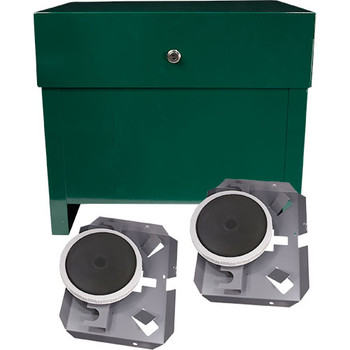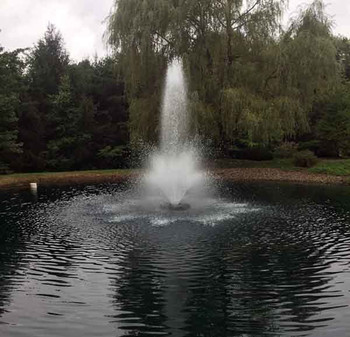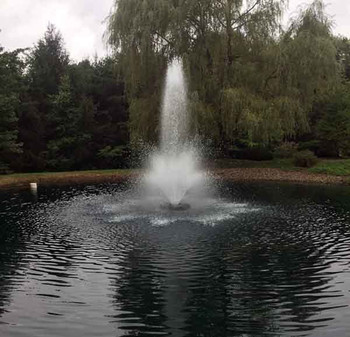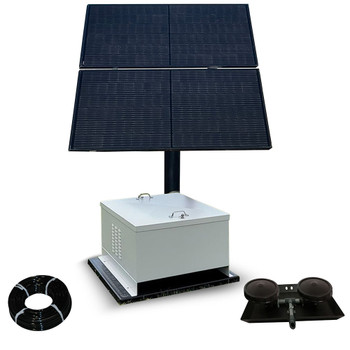-

PowerAir 2 Bottom Diffused Aeration System $2,149.99PowerAir 2 Pond Aerator System Breathe life into your pond with the energy efficient PowerAir Pond Aeration System. Improve dissolved oxygen levels at all water depths to create oxygen rich habitat for aquatic life. Lower carbon dioxide...$2,149.99 -

KASCO High Oxygen Transfer Aerator 3/4 HP $1,325.00 - $2,333.00KASCO High Oxygen Transfer Aerator 3/4 HP - Surface Aerator Moves high volumes of water Increases dissolved oxygen in water Improves water quality Built for commercial applications Can be used in freshwater or saltwater All Kasco pond...$1,325.00 - $2,333.00 -

PowerAir 1 Bottom Diffused Aeration System $1,749.99PowerAir 1 Pond Aerator System Breathe life into your pond with the PowerAir Bottom Diffused Aeration System. By increasing dissolved oxygen levels throughout all depths of water, you open up the entire pond to be inhabited by aquatic life. Ponds need...$1,749.99 -

KASCO High Oxygen Transfer Aerator 1 HP $1,620.00 - $3,218.00KASCO High Oxygen Transfer Aerator 1 HP Model 4400AF - Surface Aerator Moves high volumes of water Increases dissolved oxygen in water Improves water quality Built for commercial applications Can be used in freshwater or saltwater All Kasco...$1,620.00 - $3,218.00 -

KASCO High Oxygen Transfer Aerator 1/2 HP $1,239.00 - $2,463.00KASCO High Oxygen Transfer Surface Aerator 1/2 HP - Surface Aerator Moves high volumes of water Increases dissolved oxygen in water Improves water quality Built for commercial applications Can be used in freshwater or saltwater All Kasco pond...$1,239.00 - $2,463.00 -

PowerAir 3 Bottom Diffused Aeration System $2,699.99PowerAir 3 Pond Aerator System Breathe life into your pond with the PowerAir Bottom Diffused Aeration System. By increasing dissolved oxygen levels throughout all depths of water, you open up the entire pond to be inhabited by aquatic life. Ponds need...$2,699.99 -

PowerAir 4 Bottom Diffused Aeration System $3,549.99PowerAir 4 Pond Aerator System Breathe life into your pond with the PowerAir Bottom Diffused Aeration System. By increasing dissolved oxygen levels throughout all depths of water, you open up the entire pond to be inhabited by aquatic life. Ponds need...$3,549.99 -

Deluxe Windmill Aeration System - 24' Tower $3,295.95Deluxe Windmill Pond Aerator Kit 24' Tower The Windmill Aeration System by Outdoor Water Solutions is the industry leader in wind driven aeration. The Balanced Camshaft Technology minimizes bearing fatigue using stainless steel components. The...$3,295.95 -

Windmill Aeration System - 12' Tower $2,295.95Windmill Pond Aerator The Windmill Aeration System by Outdoor Water Solutions is the industry leader in wind driven aeration. The Balanced Camshaft Technology minimizes bearing fatigue using stainless steel components. The self governing head protects...$2,295.95 -

VERTEX Air 2 XL4 Aeration System $3,756.00VERTEX Air 2 XL4 Aeration System Air 2 XL4 aerates approximately 3-5 acres depending on shape, slope, oxygen demand and other factors. Vertex’s latest technology provides the most aeration for your money. A Brookwood SafeStart compressor, housed...$3,756.00 -

VERTEX Air 1+ XL2 Aeration System $3,353.00VERTEX Air 1 Plus XL2 Aeration System Air 1+ XL2 aerates approximately 1-2 acres depending on shape, slope, oxygen demand and other factors. Vertex’s latest technology provides the most aeration for your money. A Brookwood SafeStart compressor,...$3,353.00 -

Windmill Aeration System - 24' Tower $2,695.95The Windmill Aeration System by Outdoor Water Solutions is the industry leader in wind driven aeration. The Balanced Camshaft Technology minimizes bearing fatigue using stainless steel components. The self governing head protects the unit during high...$2,695.95 -

Otterbine Aerating Fountain 3 HP Otterbine Aerating Fountain 3 HP Otterbine Aerating Fountains should not be confused with ordinary floating fountains. These surface spray aerators are engineered to provide results and although they create attractive displays, selection should be based... -

NightAir 2 Solar Aeration System with Battery Backup $12,595.95NightAir™ 24v Solar Powered Pond Aerator System with Battery Backup NightAir Solar Aeration combines the strength and output of an electric powered aerator with the benefit of solar technology to run your system off-grid. Aerates up to 1.5...$12,595.95 -

KASCO Surface Aerator 3 HP $4,317.00 - $10,145.00KASCO Surface Aerator 3 HP Model 3.1AF Moves high volumes of water Increases dissolved oxygen in water Improves water quality Built for commercial applications Can be used in freshwater or saltwater All Kasco aerators for ponds are...$4,317.00 - $10,145.00 -

Kasco RobustAire Lake Aeration System $9,921.00 - $12,771.00Kasco RobustAire Diffused Aeration System for Lakes & Large Ponds • Quietest Lake Aerator • No Electricity in the Water / Safe for...$9,921.00 - $12,771.00 -

KASCO Surface Aerator 2 HP $3,429.00KASCO Surface Aerator 2 HP Model 8400AF Moves high volumes of water Increases dissolved oxygen in water Improves water quality Built for commercial applications Can be used in freshwater or saltwater All Kasco aerators for ponds are...$3,429.00 -

Otterbine Aerating Fountain 5 HP Otterbine Aerating Fountain 5 HP Otterbine Aerating Fountains should not be confused with ordinary floating fountains. These surface spray aerators are engineered to provide results and although they create attractive displays, selection should be based... -

NightAir 1 Solar Aeration System with Battery Backup $12,395.95NightAir™ 24v Solar Powered Pond Aerator System with Battery Backup NightAir Solar Aeration combines the strength and output of an electric powered aerator with the benefit of solar technology to run your system off-grid. Aerates up to 0.75...$12,395.95
FREE Pond Cleanse Treatment with Aerator purchase - Pond Cleanse will automatically add to cart.
Select the Best Pond Aerator
Types of Pond Aerators
Pond aerators are essential for circulating pond water and managing water quality. There are several different styles of pond aerator that can be used to oxygenate water for a healthier pond ecosystem.
What are the 2 main types of pond aerators?
Pond Bottom aeration systems use compressed air to circulate pond water from the bottom to the top. As the water moves to the surface it exposed to oxygen-rich air and oxygen dissolves in the water while carbon dioxide, methane, and other gasses are released to the atmosphere. Bottom pond aerators are the most energy efficient aeration systems.
Surface aerators also oxygenate pond water and, in many styles, provide a decorative fountain spray. This, coupled, with the sound of falling water from the pond fountain, makes the surface aerator a popular choice. The surface pond aeration systems can have significant operating costs.
How do Aeration Systems Raise Oxygen Levels?
In the case of bottom aeration systems, rising bubbles create vertical flow drawing water from the bottom of the pond to the surface. Once at the surface, the water exchanges carbon dioxide and other gases for oxygen resulting in more dissolved oxygen for fish and other aquatic organisms.
Surface aerators improve pond circulation and also create oxygen-rich water by spraying the water through the air and also creating a mixing zone of atmospheric air and water when the water crashes to the pond surface. With this type of aeration system, you can actually see the process as an oxygenated white foam forms at the surface. These pond aeration systems are best used in shallow ponds where thermal stratification does not prevent mixing of the water in deeper areas of the pond.
Bottom pond aerators generate rising columns of small bubbles that both add oxygen to the water and circulate water from the bottom of the pond to the top of the pond. This is the most energy efficient method of pond aeration.
Surface aerators rely on moving high volumes of water with a submersible pump. A low resistance nozzle is used to create a low, frothy spray that mixes air with the pond water. Floating pond aerators are generally most efficient in shallow ponds with depths less than 6 feet.
Is it Possible to Aerate a Pond Without a Power Source?
Yes, off-grid pond aeration is a real possibility. Solar pond aerators and windmill aerators both improve oxygen levels in remote bodies of water. For both solar aerators and wind aeration systems the amount of oxygen added to the pond will be less than a conventionally powered system. However, some aeration (and circulation) is better than none and will improve water conditions!
There are 2 types of solar pond aeration systems.
- A solar aeration system with electrical storage includes battery packs that operate the aeration pump at night and on cloudy days.
- A direct solar aerator only operates the aeration pump when the sun is shining on the solar panels.
Of the 2, the best solar aeration system is the storage system since oxygen levels in a pond or lake are lowest during darkness.
Windmill aerators force compressed air to aeration diffusers under the water creating pond circulation and, in turn, improving oxygen levels. Unfortunately, windmill pond aeration systems only add oxygen to the pond when the wind is blowing hard enough to turn the windmill and operate the attached air pump.
When the wind is blowing with enough velocity to effectively operate the windmill pond aerator, it is also likely pushing water towards one side of the pond and effectively circulating some of the pond water. In a stratified pond, this will only add oxygen to the surface water above the thermocline so there is still value in the windmill aerator. Additionally, for ponds that are sheltered from the wind, the aerator can be placed some distance away at a higher elevation to capture wind when the pond is not circulated by the wind.
Aeration diffuser disks create rising columns of bubbles that move incredible volumes of water to the pond surface.
What are the Benefits of Lake and Pond Aeration?
There are many benefits of pond and lake aeration.
First, the fish in the pond benefit from high oxygen levels because they draw water through their gills to breathe. High dissolved oxygen levels reduce fish stress and allow them to breathe easily. Some species of fish, such as trout, require high oxygen levels to survive. Improving aeration increases the number of species that can live in a fish pond.
Second, aerobic bacteria that digest nutrients and other pond waste thrive in high-oxygen water. Improving pond aeration and circulation allows these microscopic organisms to work efficiently to keep pond water clean.
Third, circulation benefits a pond or lake ecosystem. Moving pond water reduces stagnation and prevents floating leaves and other waste that contribute to pond muck from accumulating. Keeping pond water moving also limits pests such as mosquito larvae and small weeds like duckweed and watermeal.
Why is aeration so important at night?
If you've ever heard about a fish kill because of low dissolved oxygen concentrations, it is almost certain that it happened at night. Why is that? In a pond or lake with significant amounts of aquatic plant life, plants and algae produce tremendous amounts of oxygen from photosynthesis during the daylight hours.
As sunlight fades, photosynthesis stops, but plant respiration continues. This means that the aquatic plants are consuming oxygen and releasing carbon dioxide. When excessive amounts of plants and/or algae are in the water colmn, this leads to rapid depletion of the dissolved oxygen. Spiking carbon dioxide (CO2) concentrations in the water can cause a number of issues. In addition to stressing or suffocating the fish population and causing a fish kill, high CO2 in the water creates conditions that allow the formation of carbonic acid which can cause the pH to drop to dangerous levels if the pond is not properly buffered against acidification by alkalinity and more specifically carbonate hardness.
Many ponds outside of limestone rich areas have low carbonate hardness and can experience pH fluctuations of over 4 points in a 24 hour period. These severe fluctions in pH stress aquatic life in numerous ways. First, the change in acidity of the water impacts fish health and behavior. Perhaps more importantly, as pH changes, other components of water chemestry alter in response.
For example, commonly occuring dissolved metals in the water column that are normally harmless to aquatic life change forms under acid conditions and become toxic.
The fluctuation in pH from biological activity can be balanced by adding pond lime and operating an effective pond aerator 24 hours a day to promote the exchange of carbon dioxide for oxygen at the pond surface throughout the nighttime hours.
What are the power requirements for bottom pond aerators?
Bottom aerators are the most energy efficient pond aeration methods. Most units require only 120 volt power supplies with less than 10 amps of current draw for even ponds up to 2 acres. 240 volt units are available as options for most aerators, but the increased voltage is merely for convenience when a 240 volt power supply is already available near the pond.
How is a pond bottom aerator installed?
A pond bottom aerator is a straight-forward installation that most DIY pond managers can complete in less than a day. One of the lessor known features of bottom aerators is that a power supply is not required immediately adjacent to the water body. Most units are capable of forcing the compressed air through a direct burial airline up to 1,000 feet to the water's edge. So, as long as power is availalbe within 1,000 feet, new electric service is not needed. However, many pond managers will decide to have a power supply installed near the pond to allow for multiple uses.
Assuming that power is available at the pond, here are the steps to install a bottom aerator.
- Prepare the compressor cabinet location. Quality, forced-air pond aerators produces a little less sound than a window air conditiong unit. Select a location where that small amount of noise will not be bothersome. If the ground is not level, level a 3 foot by 4 foot area. The compressor cabinet is best placed on either a concrete slab or a firm bed of gravel that will allow water to drain away from the air pump cabinet.
- Once the air pump location is ready, unbox the pond aerator cabinet. Place the cabinet with the back of the compressor cabinet at the edge of the pad. This is where the air line connections exit the cabinet. Dig a shallow trench from the air line location to the pond and continue to at least 6 inches of water depth.
- Unbox the aeration diffuser(s) and assemble them according to the enclosed directions.
- Unbox and uncoil the weighted airline so that it lays flat along the edge of the pond without any loops or kinks.
- Place a hose clamp loosely over one end of the self-weighted airline. Slide one end of the self-weighted airline on to the barbed fitting at the pond aerator cabinent. Tighted the provided hose clamp securely over the barbed airline fitting. Repeat this process at the weighted pond aeration diffuser barb fitting connection. Repeat for additional oxygenation diffusers. Turn the compressor on and check for air leaks at the connections using a bit of soapy water. Keep the compressor running for step 6 as the diffusers will keep themselves upright during placement.
- Attach a nylon or other synthetic rope to the weighted base of the pond diffuser. Many pond managers prefer to attach a buoy to the aeration diffuser so that in can be easily located in the future. If this is the case, secure the rope permenantly. If not attaching a buoy, slide the rope through the center opening of the weighted base and hold both ends in your hand. This will allow the rope to be pulled through the base and retrieved once the diffuser is placed. Using a small boat pull the diffuser to it's desired location and lower in to place.
- If installing a multiple diffuser aeration system, use the manifold valves in the compressor cabinet to adjust the airflow to each diffuser until the airflow is balanced among the diffuser plates.
Introduce aeration to the pond gradually. Run the aerator for 1 hour on day 1, 2 hours on day 2, 4 hours on day 3, 8 hours on day 4, 12 hours on day 5, and begin 24 hour operation on day 6. On day 7, rest and enjoy!
Additional Benefits of Pond Aeration
Aeration is an efficient and cost-effective method of oxidizing iron, manganese, hydrogen sulfide, carbon dioxide, methane, and volatile organic carbons. The process of aeration involves introducing air into a water body to promote the efficient exchange of oxygen molecules between the atmosphere and the liquid. This is done by injecting oxygen-rich air into the water in order to improve its quality.
As a result of aeration, oxygen levels are increased which allows for improved degradation of pollutants or contaminants present in the water. This also helps to prevent odor and taste problems associated with low oxygen concentrations in water bodies. Additionally, it can help improve aquatic life since fish and other aquatic life require dissolved oxygen for survival.
Aeration also has great potential for eliminating gases such as hydrogen sulfide, carbon dioxide, methane, and volatile organic carbons that are often found in eutrophic water bodies. By using this technique, these gases can be effectively removed from the water resulting in better performance from treatments as well as improved nutrient cycling and odor.
Overall, aeration is an effective way to improve the overall quality of a water body through oxidation mechanisms for various materials as well as removing certain gaseous substances from it before further treatment processes take place. This process has been widely used around the world due to its relatively low cost compared to other means of treating water bodies while still providing desirable outcomes for it's users.
Water appears to boil because rising bubbles from the aerator create flow which efficiently circulates pond water.
